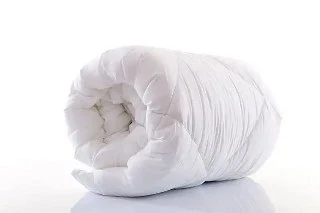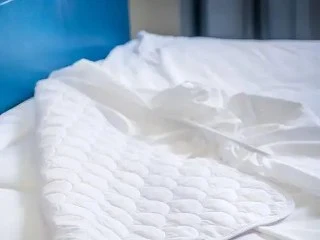Comforter
A comforter is a type of bed made of two lengths of fabric or covers sewn together and filled with insulating materials for warmth, traditionally down or feathers, wool or cotton batting, silk, polyester, and other down substitute fibers. Like quilts, comforters are usually laid over top bed sheets. Duvets are another form of quilt, traditionally filled with feathers, although since the late 20th century often been made with synthetic fibers or down substitutes.
Sometimes, a comforter is covered for protection and prolonged use. Comfort covers are similar in principle to pillows, usually closed with zippers or buttons.
In the UK, the term comforter is not commonly used. It is also called a quilt, duvet, or eiderdown. A duvet is different in that it is thicker and is usually used without blankets or extra sheets.
Comforters are generally used during the winter season when it is very cold, although the variety of thicknesses means that they can be used in other seasons as well, with lighter examples being used in warmer weather. Because of the thickness of a comforter or the amount of down/feather or other fillings it contains, a person is insulated from the cold.
Sometimes a comforter is sold as part of a "bed in a bag," usually a case with handles that holds a complete set of bedding in the same or a matching pattern: comforter and top sheet, fitted sheet, pillow case, and possibly pillow shams. Some sets have duvets and duvet covers in place of comforters and top sheets.
Silk comforter
A silk comforter is a bed cover, often used as a duvet, and is also commonly referred to as a silk duvet, silk quilt, or silk blanket. Originally used and made in China, since the late 20th century, silk comforters have become more common in Western market areas. Their growing popularity stems from a combination of factors, including their thermal properties, their lightweight, and their natural hypoallergenic properties. The opening of the Chinese market to the world in the 1990s also played an important role in the spread of silk comforters, as China is both the world's largest producer of silk and a manufacturer of silk comforters.
During the production of the silk comforter, however, the silk filaments are not unraveled, but rather stretched into a flat tangled mesh and layered to create the silk floss, which will fill the comforter.
At first, boiling the cocoons loosens the sericin holding the filaments and kills the silkworm. All cocoon is stretched by hand one by one on a U-shaped wooden rack and the ball of yarn becomes a sheet of tangled fibers. This sheet is again stretched by hand on a larger rack, along with several other cocoons to form a thick, cottony bundle called silk floss. It takes hundreds of these bundles to make one silk comforter. A silk comforter making needs hundreds of these bundles.
Once enough silk cocoons have been stretched into bundles, the silk comfort begins to take shape. Workers hold the ends of the bundle and stretch it to match the desired comforter dimensions and layer by layer the comforter begins to take shape. It can take anywhere from 100 to 400 of these thin layers to make a comforter, depending on the dimensions of the bed and the desired thickness. Since it takes many cocoons to make each layer, a silk comforter can be made up of thousands of silk cocoons.
When the silk fiber layers are stacked together, they are sealed inside the silk or cotton fabric and the comforter is completed. The result is extremely lightweight despite the thickness of the silk comforter. Silk comforters offer excellent insulating properties like down, but tend to be less bulky than down duvets. Silk is a breathable fabric, which makes silk comfortable in a wide temperature range. Even in summer, thin silk comforters are used.










0 Comments